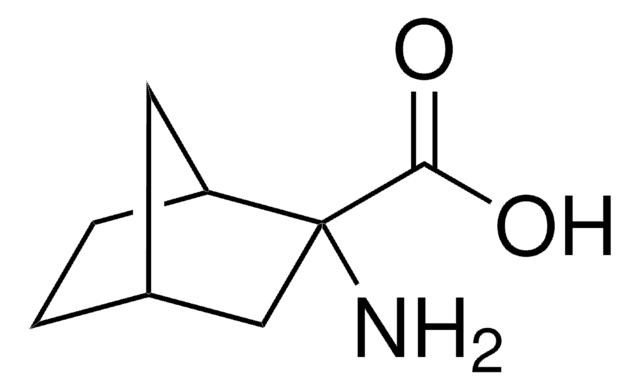G2253
L-Glutamic acid γ-monohydroxamate
≥97% (TLC)
Sinonimo/i:
L-γ-Glutamylhydroxamic acid, L-5-N-Hydroxyglutamine
Autenticatiper visualizzare i prezzi riservati alla tua organizzazione & contrattuali
About This Item
Formula empirica (notazione di Hill):
C5H10N2O4
Numero CAS:
Peso molecolare:
162.14
Numero MDL:
Codice UNSPSC:
12352209
ID PubChem:
NACRES:
NA.26
Prodotti consigliati
Nome del prodotto
L-Glutamic acid γ-monohydroxamate,
Saggio
≥97% (TLC)
Livello qualitativo
Stato
powder
Colore
white to off-white
applicazioni
detection
Temperatura di conservazione
−20°C
Stringa SMILE
NC(CCC(=O)NO)C(O)=O
InChI
1S/C5H10N2O4/c6-3(5(9)10)1-2-4(8)7-11/h3,11H,1-2,6H2,(H,7,8)(H,9,10)
YVGZXTQJQNXIAU-UHFFFAOYSA-N
Applicazioni
L-Glutamic acid γ-monohydroxamate has been used as a standard to calculate transglutaminase (TGase) activity.
Azioni biochim/fisiol
L-Glutamic acid γ-monohydroxamate [L-Glu(gamma)HXM] is used as a vanadium ligand which potentiates vanadiums metabolic activity. L-Glu(gamma)HXM is also used as a substrate for E. coli asparagine synthetase B and as an ATP-dependent irreversible inhibitor of Escherichia coli gamma-glutamylcysteine synthetase.
Codice della classe di stoccaggio
11 - Combustible Solids
Classe di pericolosità dell'acqua (WGK)
WGK 3
Punto d’infiammabilità (°F)
Not applicable
Punto d’infiammabilità (°C)
Not applicable
Dispositivi di protezione individuale
Eyeshields, Gloves, type N95 (US)
Scegli una delle versioni più recenti:
Possiedi già questo prodotto?
I documenti relativi ai prodotti acquistati recentemente sono disponibili nell’Archivio dei documenti.
I clienti hanno visto anche
M Katoh et al.
Bioscience, biotechnology, and biochemistry, 62(7), 1455-1457 (1998-08-28)
Incubation of Escherichia coli gamma-glutamylcysteine synthetase with L-glutamic acid gamma-monohydroxamate and ATP caused slow but irreversible inhibition of the enzyme, and more than 90% activity was lost in three days. The enzyme was not inactivated when ATP was absent or
N Seiler et al.
Neurochemical research, 15(3), 301-305 (1990-03-01)
The method for the assay of glutamine synthetase (GlnS) relies on the gamma-glutamyl transferase reaction, i.e. the formation of glutamyl-gamma-hydroxamate from glutamine and hydroxylamine, and the chromatographic separation of the reaction product from the reactants. The method is not only
X Huang et al.
The Journal of biological chemistry, 275(34), 26233-26240 (2000-08-22)
The x-ray crystal structure of the heterodimeric carbamoyl phosphate synthetase from Escherichia coli has identified an intermolecular tunnel that connects the glutamine binding site within the small amidotransferase subunit to the two phosphorylation sites within the large synthetase subunit. The
N Thomasset et al.
Anticancer research, 13(5A), 1393-1398 (1993-09-01)
We have previously shown that L-glutamic acid gamma-monohydroxamate (GAH) exhibits an antitumor activity, both in vitro and in vivo. In this report we explore the selective cytotoxicity of GAH in vitro by comparing the survival of tumor and normal cells.
C J Lusty
FEBS letters, 314(2), 135-138 (1992-12-14)
E. coli carbamyl phosphate synthetase binds 0.2-0.4 mol equivalents of glutamine in an acid resistant form. The bound material is quantitatively released as glutamate by weak base hydrolysis and as a mixture of 12% glutamate, 10% gamma-glutamylhydroxamate, and 70% pyrrollidonecarboxylic
Il team dei nostri ricercatori vanta grande esperienza in tutte le aree della ricerca quali Life Science, scienza dei materiali, sintesi chimica, cromatografia, discipline analitiche, ecc..
Contatta l'Assistenza Tecnica.










